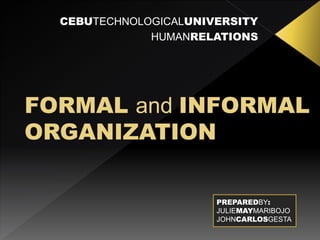
Formal vs informal organization
- 1. CEBUTECHNOLOGICALUNIVERSITY HUMANRELATIONS PREPAREDBY: JULIEMAYMARIBOJO JOHNCARLOSGESTA
- 2. The Formal Organization is a system of well-defined jobs, each bearing a definite measure of authority, responsibility and accountability. Louis Allen Formal Organization is a system of consciously coordinated activities of two or more persons toward a common objective. Chester Barnard
- 3. The formal organization is a goal-oriented entity that exist to accurate the efforts of individuals and it refers to the structure of jobs and positions with clearly defined functions, responsibilities and authorities
- 5. To facilitate the accomplishment of the goals of the organization To facilitate the co-ordination of various activities To aid the establishment of logical authority relationship To aid the establishment of division of labor Create group cohesiveness
- 6. 1. Well defined rules and regulation
- 8. 3. Determined objectives and policies
- 9. 4. Limitation on the activities of the individual
- 10. 5. Strict observance of the principle of coordination
- 11. 6. Messages are communicated through vertical chain
- 12. 7. Status symbol
- 13. Set specific Goals for organization Establishing working relationship Create group cohesiveness Organizational Development Discipline Human Resource Development
- 14. b) Social Aspects of benefits: a) Financial Aspects of benefits: Security Slow but steady promotion Commissioned ranks open to men and women graduates Can't be fired Good retirement benefits Many different branches appeal to different interests Social Status See interesting places and people
- 15. Limited Flexibility Slowness of processing Communication Barrier Quality of decision Slowness in Problem detection & processing
- 16. An Informal organization is an aggregate of interpersonal relationships without any conscious purpose but which may contribute to joint results. Chester Barnard Informal organization is a network of interpersonal relationship that arise when people associate with one another . Keith Davis
- 17. The informal organization is the interlocking social structure that governs how people work together in practice. It is the aggregate of behaviors, interactions, norms, personal and professional connections through which work gets done and relationships are built among people who share a common organizational affiliation or cluster of affiliations.
- 18. Chess group Bowling Team Morning coffeee regulars Cricket lovers
- 19. Informal Leader- The leader of an informal organization is elected by the members of the groups for different reasons such as age, seniority, technical, competence, work location, and responsive personality, etc. depending upon the work situation. Role of Informal Leader: a) To help the group reach its goals, and b) To maintain and enhance group life.
- 20. Evolving constantly Grass roots Dynamic and responsive Excellent at motivation Requires insider knowledge to be seen Treats people as individuals Flat and fluid Trust and reciprocity Difficult to pin down Essential for situations that change quickly or are not yet fully understood
- 21. Perpetuate the cultural and social values
- 22. Provide social status and satisfaction
- 23. Promote communication among members
- 24. Provide social control
- 25. Better Total System Lighter workload for management Work group satisfaction A safety valve for emotions Cohesiveness Fill up gaps Channel of employee communication To plan and act more carefully Encourage Cooperation Understanding and Dealing with the Environmental Crisis Encourage improved management practice
- 26. 1) Resistance to change 2) Role conflict 3) Rumor 4) Conformity 5) Undermine discipline 6) Power politics 7) Interpersonal and intergroup conflicts
- 27. INFormal Formal has its own rules and regulation that must be followed by the members (employees and managers) has a system of co-ordination and authority. has a clear superior-subordinate relationship the objectives are specific and well-defined all the members are given specific duties and responsibilities. does not have its own rules and regulation has no system of co-ordination and authority doesn't have any superior-subordinate relationship or any specific and well-defined objectives communication is done through the grapevine
- 28. INFormal Formal formed by the top level management formed by social forces within the formal organization
- 29. The members have to follow certain rules and regulations. These rules are available in writing (documented). They are made by a formal authority (superiors). If the members follow these rules properly, then they will be rewarded. However, if they do not follow these rules, they will be punished. The members of an informal organization do not have to follow any rules and regulations INFormal Formal
- 30. the duties, responsibilities, authority and accountability of each member is well-defined there are no fixed duties, responsibilities, authority, accountability, etc. for the members INFormal Formal
- 31. the objectives or goals are specific and well-defined The main objectives are productivity, growth, and expansion the objectives are not specific and well-defined The main objectives are friendship, security, common interest, individual and group satisfaction, etc inFormal Formal
- 32. The members get financial benefits and perks like wages or salaries, bonus, travelling allowances, health insurance, etc. The members get social and personal benefits like friend circle, community, groups, etc. inFormal Formal
- 33. stable uses formal channels of communication. shown on the organization chart not stable uses informal channels of communication (i.e. grapevine) not shown on the organization chart inFormal Formal
